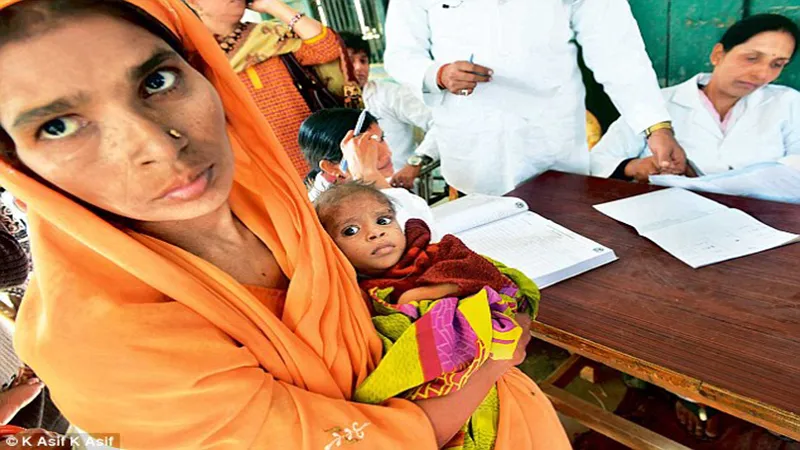India got a reality check recently when newspapers splashed the shocking conclusions of the first Socio-Economic and Caste Census (SECC) since 1934, which revealed the extent of rural deprivation.
Its primary finding was that rural households make up nearly three quarters of the country's population, some 884 million people, and that an overwhelming 74 per cent of them survive on a monthly income of Rs 5,000 for their highest earner.
The message from these staggering numbers is obvious: India has to resolve some very basic issues within before it can aspire to be any kind of power, regional or global.
With agriculture contributing just 13.7 per cent to the Indian Gross Domestic Product, it is clear that the rural situation is a millstone around the country's neck, rather than being an asset in the transformation of our economy.
But this millstone happens to comprise of people - hundreds and millions of men, women and children who are illiterate, poor and hungry.
Rural Assets
More than half of these households do not own any land, the primary rural asset. And neither are they able to create other assets because they lack education. Thirty-six per cent of them are illiterate and the rest of those considered literate barely qualify since they have not even completed high school.
In practical terms a vast number of households have to struggle hard to get food, potable water, have no power or toilets. The consequences of this are illiteracy, malnutrition, and vulnerability to disease.
As another report being suppressed by the government and revealed by The Economist notes, fully 30 per cent of the country's children suffer from malnutrition and its terrible consequences of "stunting" and "wasting" - being abnormally short or underweight. You can be sure most of these folk are from the rural areas too.
Over the years, a large number of people have worked their way out of poverty, gained literacy, acquired the trappings of middle class living like refrigerators, washing machines, and a two or four-wheeled vehicle. But the SECC has just opened our eyes to the sheer scale of poverty that continues to blight our land.
Because this deprivation is rural, many of those who make policy, read newspapers, and shape the discourse of the country through the TV, never really get to grasp what it means.
Hidden away in the backwaters of Bihar, Jharkhand, Chhattisgarh or Orissa, even the minor illness of an earning member of the household can mean slow starvation and death.
Sadly, richer states are not too different - 47.6 per cent of rural Rajasthan remains illiterate and the much-touted Gujarat's child malnutrition rates of 33.3 per cent are higher than the national average.
At a macro level it is obvious that the country needs a manufacturing revolution, as Prime Minister Modi says, to shift these millions into productive occupations. But the issue is not simply one of investments, ease of doing business, FDI and the other buzzwords you hear, but of a process that would first eliminate hunger and disease and provide education to the rural masses.
The figures say, for example, that only 5.4 per cent of the people in rural India have completed high school, and only 3.4 per cent have graduated from college.
Red Herrings
With these numbers, who or what will populate your factories? "Make in India" or MNREGA are red herrings. What the country needs to urgently work on is an sweeping agrarian revolution.
For too long policy - essentially subsidising fertiliser and providing unsustainable support prices - has drifted. In the meantime, the size of holdings has declined, even as the number of persons dependent on those holdings has increased. The water table has dropped precipitously.
Biggest Problem
But the biggest problem has been the fractured Indian agricultural market, dominated as it is by Agriculture Produce Marketing Committees. The result is that there are situations where brinjal is selling for Rs 300 a quintal in Punjab and Rs 3,000 a quintal in Gujarat at the same time.
Middle-men distort the prices and availability of commodities. India does not have the option of forcing the process, as was done in the Soviet Union and China, and as the experience of countries like the US and Japan shows, it is not easy to reform the agricultural sector in democratic countries as well because of its political clout.
But for India there is, perhaps, little choice. Politicians have been kicking the can down the road for the past decades. Now, they have accumulated to form the millstone that will block the progress of the country.
Bold steps are needed to create a new agricultural paradigm, or else the country is condemned to walk on the development treadmill forever.
(The writer is a Contributing Editor, Mail Today and a Distinguished Fellow, Observer Research Foundation, Delhi)
Courtesy: Mail Today
The views expressed above belong to the author(s). ORF research and analyses now available on Telegram! Click here to access our curated content — blogs, longforms and interviews.




 PREV
PREV


